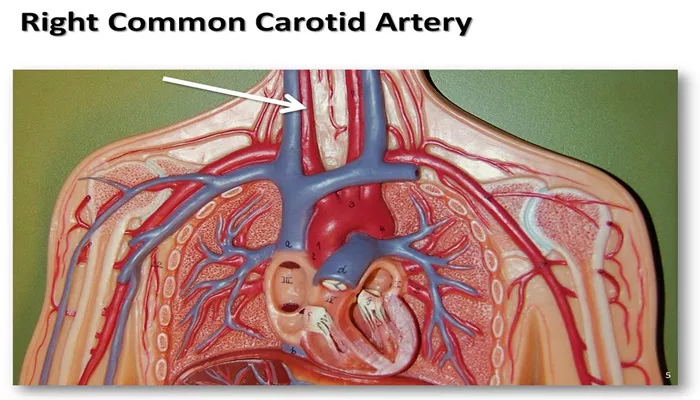Carotid artery blockage is a significant medical condition that poses serious health risks, including stroke. The carotid arteries are two major blood vessels located on each side of the neck that supply blood to the brain. When these arteries become narrowed or blocked, it can lead to reduced blood flow, which is critical for brain function. This article explores the mechanisms behind carotid artery blockage, its causes, risk factors, symptoms, diagnosis, and treatment options.
What Causes Carotid Artery Blockage?
The primary cause of carotid artery blockage is atherosclerosis, a condition characterized by the buildup of fatty deposits known as plaques within the arterial walls. These plaques consist of cholesterol, fat, calcium, and other substances found in the blood. Over time, this buildup narrows the arteries and can eventually obstruct blood flow. The process of atherosclerosis is gradual and often asymptomatic in its early stages.
Specific Reasons for Carotid Artery Blockage
Atherosclerosis: As mentioned, this is the main cause of carotid artery blockage. The plaques can harden and narrow the arteries, making it difficult for blood to flow freely. This condition can lead to ischemic strokes when blood flow to the brain is significantly reduced or blocked.
Risk Factors:
High Blood Pressure: Hypertension can damage arterial walls and contribute to plaque formation.
High Cholesterol Levels: Elevated levels of low-density lipoprotein (LDL) cholesterol promote plaque accumulation in the arteries.
Diabetes: This condition affects how the body processes fats and sugars, increasing the likelihood of atherosclerosis.
Smoking: Tobacco use damages blood vessels and accelerates plaque buildup.
Obesity: Excess weight contributes to high blood pressure and diabetes, both of which are risk factors for carotid artery disease.
Age: The risk of developing carotid artery disease increases with age due to changes in arterial elasticity and structure.
Family History: A genetic predisposition can increase an individual’s risk for atherosclerosis and related conditions.
see also: How Much Carotid Artery Blockage Is Normal?
Other Contributing Factors:
Lack of Physical Activity: Sedentary lifestyles can lead to obesity and other cardiovascular risk factors.
Unhealthy Diet: Diets high in saturated fats, trans fats, and cholesterol can accelerate plaque formation in the arteries.
Chronic Inflammation: Conditions that cause chronic inflammation may also contribute to arterial damage and plaque buildup.
Symptoms of Carotid Artery Blockage
In many cases, carotid artery blockage does not present symptoms until significant narrowing occurs. Common symptoms include:
Transient Ischemic Attack (TIA): Often referred to as a “mini-stroke,” TIAs can cause temporary symptoms such as weakness on one side of the body, confusion, difficulty speaking, or loss of vision. These symptoms typically resolve within 24 hours but indicate a higher risk for future strokes.
Stroke Symptoms: If a stroke occurs due to carotid artery blockage, symptoms may include sudden numbness or weakness (especially on one side), confusion, trouble speaking or understanding speech, vision problems in one or both eyes, dizziness, or loss of balance.
Diagnosis of Carotid Artery Blockage
Diagnosis typically involves several steps:
Physical Examination: A healthcare provider may listen for abnormal sounds (bruits) in the neck using a stethoscope.
Imaging Tests:
Carotid Ultrasound: This non-invasive test uses sound waves to create images of the carotid arteries and assess blood flow.
CT Angiography or MR Angiography: These imaging techniques provide detailed pictures of blood vessels and help identify blockages.
Blood Tests: Evaluating cholesterol levels and other markers can help assess cardiovascular risk factors.
Treatment Options for Carotid Artery Blockage
Treatment aims to reduce the risk of stroke and improve blood flow through lifestyle changes, medications, or surgical interventions.
Lifestyle Changes
Dietary Modifications: Adopting a heart-healthy diet low in saturated fats and high in fruits, vegetables, whole grains, and lean proteins can help manage cholesterol levels.
Regular Exercise: Physical activity helps maintain a healthy weight and lower blood pressure.
Smoking Cessation: Quitting smoking significantly reduces cardiovascular risks.
Weight Management: Maintaining a healthy weight helps control diabetes and hypertension.
Medications
Antiplatelet Agents: Drugs like aspirin or clopidogrel are prescribed to prevent blood clots from forming.
Statins: These medications lower cholesterol levels and stabilize plaques in arteries.
Surgical Procedures
For severe cases where there is significant blockage:
Carotid Endarterectomy (CEA): This surgery involves removing plaque from the carotid artery to restore normal blood flow.
It is typically recommended for patients with 70% or more blockage who have experienced symptoms like TIAs or strokes.
Carotid Angioplasty and Stenting (CAS): This less invasive procedure involves inserting a catheter into the artery to place a stent that keeps it open after ballooning the narrowed area. It is often used in patients who are not candidates for CEA due to health issues.
Conclusion
Carotid artery blockage is a critical health concern that requires awareness and proactive management. Understanding its causes—primarily atherosclerosis—and recognizing risk factors can aid in prevention efforts. Regular medical check-ups are essential for early detection and intervention. By adopting healthier lifestyles and adhering to medical advice regarding treatment options, individuals can significantly reduce their risk of stroke associated with carotid artery disease.
Related topics:
- Will Ekg Show Heart Blockage
- What Is A Coronary Artery Bypass Graft For?
- Elevated Atherogenic Index Linked to Increased Risk of Erectile Dysfunction

